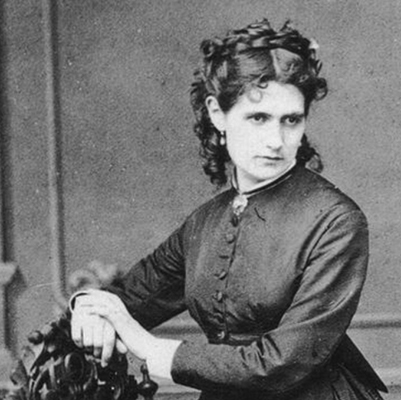BERTHE MORISOT (1841-1895)
 This charming, intimate portrait of a young woman with dark hair and a dreamy expression dressed in a white muslin gown decorated with blue sprigs is typical of the work of the quintessentially Impressionist painter Berthe Morisot. Morisot was one of the few women artists among the Impressionists who emerged as a fringe group of artists in Paris in the early 1870s. Morisot was particularly close to the great painter associated with the Impressionists (although he never actually exhibited with them), Edouard Manet, who painted several portraits of her. She married Manet’s brother Eugène. The diary kept by their daughter Julie Manet is one of the most important first-hand sources of information on the Impressionist movement. The other well-known artist who was part of the movement was the American Mary Cassatt.
This charming, intimate portrait of a young woman with dark hair and a dreamy expression dressed in a white muslin gown decorated with blue sprigs is typical of the work of the quintessentially Impressionist painter Berthe Morisot. Morisot was one of the few women artists among the Impressionists who emerged as a fringe group of artists in Paris in the early 1870s. Morisot was particularly close to the great painter associated with the Impressionists (although he never actually exhibited with them), Edouard Manet, who painted several portraits of her. She married Manet’s brother Eugène. The diary kept by their daughter Julie Manet is one of the most important first-hand sources of information on the Impressionist movement. The other well-known artist who was part of the movement was the American Mary Cassatt.
Morisot grew up in a well-to-do upper middle-class family in Paris. Her father was a senior civil servant. From an early age she demonstrated her ambition to become a professional artist. Her mother arranged for her to copy in the Louvre where Morisot was attracted to the works of Rubens, Veronese, and the French masters of the eighteenth century, and to study with the famous artist Camille Corot who was renowned for his landscapes and female portraits painted in a refined and subtle palette, a quality which remained a characteristic of Morisot’s own painting.
The identity of the sitter of this portrait is not known, but she bears a close resemblance to the left hand figure in The Sisters, c. 1869 (National Gallery of Art, Washington, DC) not only in her features and facial expression but also in the white muslin dress with blue spots. It may be that she is one of “the little Delaroches” whom Berthe referred to in a letter at the time but about whom nothing is known. Morisot was above all a painter of the human figure and her subjects were mostly women and children in her domestic circle. As an upper middle-class woman artist in nineteenth-century France, her options were far more limited than those of her male colleagues. She could not, for example, wander freely about the streets and parks of Paris in search of subjects for her paintings. And the noisy, bohemian cafés where Manet, Cézanne, Degas, Renoir, Pissarro and others would argue bout their latest artistic theories would have been completely out of bounds to her. Morisot was, nevertheless, highly respected by her male colleagues, especially Manet. She not only exhibited in all of the Impressionist group exhibitions from 1874 to 1886,
except for the fourth exhibition in 1879 when she was ill following the birth of her daughter, but she also played an active role in their organization. Her home was also a regular meeting place for intellectuals and writers of the day, including the famous poet Stéphane Mallarmé, and for the Impressionist artists.
Although her range of subjects was necessarily limited, Morisot succeeded in painting many exquisite portraits of her sister, mother, daughter and friends. Often the setting is a typical drawing or sitting room of a Parisian bourgeois apartment, or a garden setting. At first, Morisot was much influenced by Corot and Manet but by the late 1870s she had developed her own highly distinctive manner applying thinly diluted paint with the utmost looseness and spontaneity. Morisot had a profound love of eighteenth-century French art, particularly Fragonard and Boucher, and their free handling and high-keyed clear color were a significant inspiration to her. Although Morisot had not yet arrived at her mature virtuoso style when she painted the present portrait in 1871, some of that sensitivity and confidence is already felt in the present portrait of a young woman, noticeably in the transparent whites of the muslin dress and the softly blended tones of the girl’s skin.
